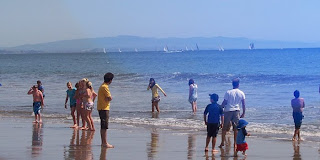Conference Of Northern Calif Handweavers had their annual conference and show this weekend. I went on Saturday to attend a class and check out the exhibits and vendors.
I met Laverne Waddington there who made it possible for me to attend a rigid heddle weaving class taught by Syne Mitchell. (thankyou-thankyou-thankyou Laverne!).
A lot of nice people in the class. Peggy Osterkamp (yeah, Peggy who writes weaving books) was at the table in front of me with a Cricket rigid heddle. Those of us with Crickets were thrilled to be able to show her a tip on using string or a rubber bands on the heddles to keep them from tipping. A trick I learned from
Patty Anne's Place, see the video a Cricket Loom Fix.
I had a problem with camera again and did not get all the pictures I tried to get.
So I'm going to borrow a couple of pictures that Laverne took.

Here I am weaving on my Cricket rigid heddle. That's Linda sitting next to me. She's an experienced weaver on multishaft looms, but she has this older model Erica rigid heddle that she is weaving with Sugar and Creme cotton yarn on a 8 dent heddle. Erica's are a cool little loom if you can get past the eccentricities. I had one in the past and I found it was good for weaving towels.
Linda's experience in weaving really comes through in her RH weaving, because she knows what she wants it to look like and she makes sure it looks how she wants it. (Did that make sense?)

This is a picture of me with Syne Mitchell. She's holding my clipboard loom and she's telling me she would have liked to put that on Weavezine as an article! So if I have another good idea, I'll have to talk her first. You can check out Weavezine at
http://weavezine.com/
Here is my latest trick. The 59 cent loom bag from IKEA.

If you shop at IKEA you can buy these big plastic shopping bags for 59 cents. We have a few at my house and since I did not want to take the Cricket loom in box, I put it in the IKEA bag.

As you can see, the loom fits, as well as some sodas, some trail mix, my clipboard loom, extra yarns, the books I bought, some fruit, and a sweatshirt. The bag has short handles and it has long handles that I was able to sling over my shoulder, even though I’m an Extra Large shirt kind of guy

I brought home literature, some books I bought, some catalogs, and a Weavolution pin! I also got to meet Aunt Janet and Tien from Weavo!
More pictures later.
It was a good day!



































